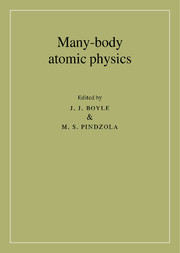Book contents
- Front Matter
- Contents
- Foreword
- Contributors
- Preface
- Acknowledgements
- Part 1 ATOMIC STRUCTURE
- 1 Development of atomic many-body theory
- 2 Relativistic many-body perturbation theory for highly charged ions
- 3 Parity nonconservation in atoms
- Part 2 PHOTOIONIZATION OF ATOMS
- Part 3 ATOMIC SCATTERING: A. General Considerations
- Part 3 ATOMIC SCATTERING: B. Low-order applications
- Part 3 ATOMIC SCATTERING: C. All-order applications
- Appendix: Units and notation
- References
- Index
3 - Parity nonconservation in atoms
Published online by Cambridge University Press: 22 September 2009
- Front Matter
- Contents
- Foreword
- Contributors
- Preface
- Acknowledgements
- Part 1 ATOMIC STRUCTURE
- 1 Development of atomic many-body theory
- 2 Relativistic many-body perturbation theory for highly charged ions
- 3 Parity nonconservation in atoms
- Part 2 PHOTOIONIZATION OF ATOMS
- Part 3 ATOMIC SCATTERING: A. General Considerations
- Part 3 ATOMIC SCATTERING: B. Low-order applications
- Part 3 ATOMIC SCATTERING: C. All-order applications
- Appendix: Units and notation
- References
- Index
Summary
Introduction
The role of atomic physics in precision tests of QED is well known. However, atomic physics has not until recently played much of a role in testing the weak interactions owing to the extremely small ratio ~ 10−11 of the energy scale of atoms to the mass of the W± and Z0 bosons. Indeed, the first discussion of parity violating effects in atoms arising from weak-neutral-current interactions between the nucleus and electrons by Zel'dovich concluded that these effects were probably too small to observe. However, after the existence of neutral-current weak interactions was established experimentally, the Bouchiats showed in 1974 that parity nonconserving (PNC) transitions in heavy atoms with atomic number Z were enhanced by a factor of Z3. While still very small, this effect has been observed in a variety of heavy atoms, specifically cesium (Z = 55), thallium (Z = 81), lead (Z = 82), and bismuth (Z = 83). These experiments deal with neutral atoms, and for this reason the electronic structure of the atoms must be understood with some precision before the experiments can be interpreted in terms of particle-physics concepts. This problem is not present for hydrogen, but PNC experiments in that atom have not proved successful.
Unfortunately, practical calculations that are accurate to the 1% level, the level of interest for particle physics, are quite difficult to carry out in heavy atoms. It is the purpose of this chapter to review the methods used in the recent highly accurate calculations of atomic PNC.
- Type
- Chapter
- Information
- Many-Body Atomic Physics , pp. 65 - 90Publisher: Cambridge University PressPrint publication year: 1998



